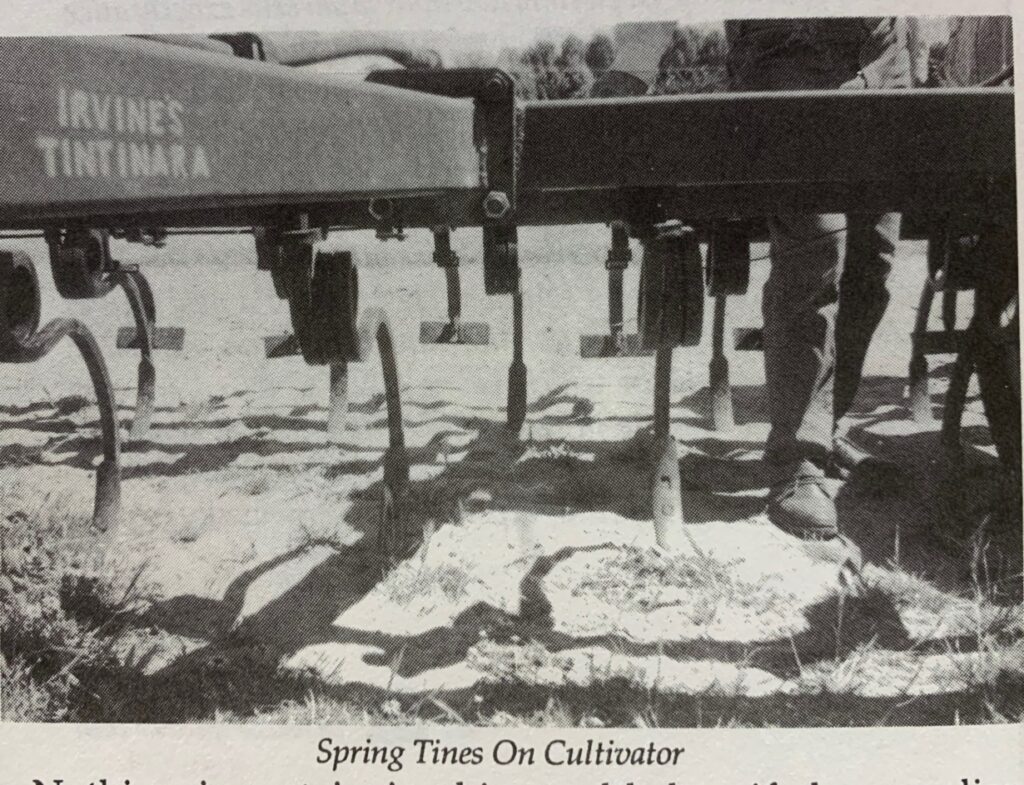Would you have guessed that it is possible to prevent weed seed germination by exposing them to a specific electromagnetic signal?
In 1991, Phillip Callahan1 first published his experiences with a uniquely designed cultivator tine that produced a frequency which inhibited weed seed germination. I am not aware that anyone has picked up this research, which seems like such a golden opportunity. Now is the time! If you know of anyone who has done work in the area, I would love to learn more about it.
Enter Phillip:
Not so very long ago I was dining with my editor, Charles Walters. I was at the 1991 Acres USA convention and Mr. Walters introduced me to an Australian gentleman seated at the same table. Our Australian friend, John McCabe, was attempting to explain how a cultivator he had modified completely eliminated weeds from his crop fields. Both Mr. Walters and I had a difficult time understanding the modification until Mr. McCabe showed us a photo of the tines on the cultivator.
Each rake like tine had a full loop along its length (see photo). In other words, each tine was a one-loop spring. It was quite obvious that each spring-loaded tine would vibrate at some low frequency made as it was dragged across the soil. The tractor vibrations would also vibrate each tine. The vibrations would enter the soil as sound since the spring would beat against the soil particles. Sound waves are pressure waves, but such a system would also have a low frequency electric radio wave associated with the sound wave. The sound wave would not penetrate the soil for any great distance since it would be muffled by soil. Low-frequency radio waves, however, penetrate to great depths in both water and soil. This is why the Navy utilizes low-frequency ELF radio waves to communicate with the atomic subs underwater.

We may understand now that common sense tells us that low-frequency, radio, especially below 1000 Hz must be significant to seeds and roots. These frequencies, even the atmospheric Shumann frequencies, easily penetrate the soil to both seeds and roots – light does not! Why study the effect of light below the soil when it is not light, but ELF radio that bathes the seeds and roots?
As far as I can determine from the literature, not a single scientist other than myself is concerned with ELF radio waves in the soil. If my thesis is correct, then a simple spring-loaded soil experiment should prove whether or not the spring-loaded tie imparts ELF radio waves into the soil. I, therefore, buried my PICRAM antenna – detector under 4 in of soil (seed depth).
Whenever I plucked a rubber band, mounted between two nails, the radio electric field penetrated the soil to my buried PICRAM detector. I could hear the sound of a rubber band in the air above the soil, but the weak sound would not penetrate the soil to a microphone below.
The sound is blocked by a few inches of soil, but the low frequency radio wave from the rubber band is not. From directly on the soil surface, to as far away as one foot above the soil, the PICRAM underground resonated to the fundamental frequency of the snapped rubberband. The frequency range for rubber bands occurs at 140 Hz for larger strong bands to a slightly higher frequency of 150 Hz for small weak bands – a range of about 10 Hz depending on rubber band size and strength.
The top Figure (1) shows the waveform at a fast sweep 5 ms (5/1000 of a second). Waves are calculated, of course, by how many occur in 1 second (One wave per second equals one Hz). Since wavelength, the distance from crest to crest is the number of waves (frequency) divided into the speed of light which is 186,000 miles per second, then the wavelength of a 140 Hz wave is:
In other words, the fundamental ELF radio frequency of a rubber band at 140 Hz equals a wave from crest to crest, 1328.5 miles long. Every time you snap a rubber band a radio wave of from 140 to 150 Hertz not only passes through the soil but also passes through your body – a mighty long wave!
The bottom sweep at a slower speed 50 Ms (50/1000 of a second) shows how the 140 Hz slowly dies out as the vibrations get weaker and weaker.
The tines on Mr. McCabe’s cultivator may or may not resonate in the same region (being a metal spring probably not) but what is certain is that they resonate somewhere in the ELF radio range between 1 and 1000 Hertz, and wherever it is, that particular tine frequency is bad for weeds and good for crops in the same way garlic can be good for digestion and bad for love.
Nothing is certain in this world, but if the peculiar Australian cultivator is doing what Mr. McCabe claims it to be doing, what is certain that with a trip to Australia, and a couple of days in those weed-free fields, it would take less than half an hour to determine the fundamental frequencies of those spring-loaded tines. That makes control of weeds as simple as generating that frequency.
(Since I wrote this in 1991 I traveled to Mr. McCabe’s farm and measured his cultivator with my PICRAM. It resonated at 720 Hz so I did not miss it by far. It is an ELF frequency!)
It is obvious that the weed seeds must store the wavelength information that causes them to go into dormancy, for the cultivator passes over any one seed in seconds.
An electronic ELF generator could be designed to transmit those ELF waves into the soil. Attached to any cultivator it would most certainly not poison the soil, for no frequency has ever been known to hang around after it has been switched off. Furthermore, the costs would be thousands of times cheaper than chemical weed killers for you buy it only once. I need hardly mention that not only do chemical weed killers kill weeds, they kill people also – Agent Orange!
From this simple weed – radio experiment my readers, I hope, will be left with a feeling for the importance of understanding the electromagnetic portion of the spectrum. By eliminating chemical poisons, fertilizers and such sick techniques of agriculture, we may not only eventually control diseases, but also increase agricultural output without destroying our spaceship earth.



